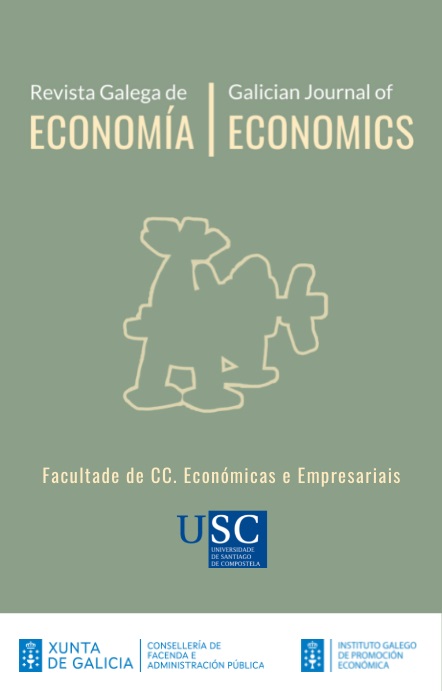El coronavirus: cisne negro y perturbación en la dotación de capital
Contenido principal del artículo
Resumen
Se analiza un shock externo provocado por un efecto extraordinario e imprevisible, un "cisne negro", como la COVID-19. Tal shock lleva a un cambio de dotación de capital en los comprados financieros, y tiene efectos sobre la desigualdad económica, el desarrollo financiero y la renta económica. Se proponen modelos teóricos en los que el sector público busca alternativas al confinamiento, permitiendo la autorregulación de la economía, grabando el capital o buscando políticas conjuntas con otros Estados. En el primero modelo, la economía se autorregula con la ayuda del sector financiero. Sin embargo, se genera desigualdad económica, por lo que en los siguientes modelos el sector público intenta intervenir. En primer lugar, el sector público minimiza la desigualdad grabando el capital, lo que permite una redistribución de la riqueza y de la renta, con un tipo impositivo que solo depende de los impactos diferenciales del cisne negro en los distintos mercados. Por último, se proponen una coordinación de políticas entre los distintos países afectados para evitar los cisnes negros y otras externalidades negativas. Esto es factible en función del tipo impositivo, de las preferencias de los hogares y de los costes de administración.
Palabras clave:
Detalles del artículo
Referencias
Adams-Prassl, A., Boneva, T., Golin, M., & Rauh, C. (2020). Inequality in the impact of the coronavirus shock: Evidence from real time surveys, Journal of Public economics, 189, 104245. DOI: https://doi.org/10.1016/j.jpubeco.2020.104245
Álvarez Espiño, M., Fernández-López, S., Rey-Ares, L., & Castro-González, S. (2020). Capacitación y comportamiento financiero de la generación millennial en España. Revista Galega de Economía, 29(3), 1-19. DOI: https://doi.org/10.15304/rge.29.3.7045
Amankwah-Amoah, J., Khan, Z., & Wood, G. (2020). COVID-19 and business failures: The paradoxes of experience, scale, and scope for theory and practice. European Management Journal, 39 (2), 179-184. DOI: https://doi.org/10.1016/j.emj.2020.09.002
Benito, A. (2006). Does job insecurity affect household consumption? Oxford Economic Papers, 58(1), 157-181. DOI: https://doi.org/10.1093/oep/gpi041
Blanchard, O., & Illing, G. (2021). The COVID-19 pandemic (version January 2021). München, Germany: Pearson Studium.
Bordo, M. D., & Meissner, C. M. (2012). Does inequality lead to a financial crisis? Journal of International Money and Finance, 31(8), 2147-2161. DOI: https://doi.org/10.1016/j.jimonfin.2012.05.006
Brunnermeier, M. K., & Koby, Y. (2018). The reversal interest rate. NBER Working Paper No. 25406. Cambridge, MA: National Bureau of Economic Research (NBER). Retrieved from: https://www.nber.org/system/files/working_papers/w25406/w25406.pdf
Calvo Bernardino, A., & Martín de Vidales Carrasco, I. (2017). Crisis financiera y reestructuración de las cajas de ahorro en España, 2003-2013. Revista Galega de Economía, 26(1), 5-18. DOI: https://doi.org/10.15304/rge.26.1.4306
Carroll, C. D., & Samwick, A. A. (1998). How important is precautionary saving? Review of Economics and Statistics, 80(3), 410-419. DOI: https://doi.org/10.1162/003465398557645
Chamon, M., Liu, K., & Prasad, E. (2013). Income uncertainty and household savings in China. Journal of Development Economics, 105, 164-177. DOI: https://doi.org/10.1016/j.jdeveco.2013.07.014
Cysne, R. P. (2009). On the positive correlation between income inequality and unemployment. The Review of Economics and Statistics, 91(1), 218-226.
Davola, A. (2020). From the black swan, to the snowball. Risks of COVID-19 pandemic for consumer credit scores in the lack of a harmonized regulatory intervention. Opinio Juris in Comparatione [Forthcoming]. DOI: http://dx.doi.org/10.2139/ssrn.3604031
Furceri, D., Loungani, P., Ostry, J. D., & Pizzuto, P. (2020). Will Covid-19 affect inequality? Evidence from past pandemics. Covid Economics. Vetted and Real-Time Papers, 12, 138-157.
Galletta, S., & Giommoni, T. (2020). The effect of the 1918 influenza pandemic on income inequality: Evidence from Italy (June 24, 2020). Social Science Research Network (SSRN). DOI: http://dx.doi.org/10.2139/ssrn.3634793
Gros, D. (2020). The great lockdown: Was it worth it? CEPS Policy Insights, No. 2020-11. Brussels, Belgium: Centre for European Policy Studies (CEPS). Retrieved from: https://www.ceps.eu/wp-content/uploads/2020/05/PI2020-11_DG_The-great-lockdown.pdf
Jantti, M. (1994). A more efficient estimate of the effects of macroeconomic activity on the distribution of income. Review of Economics and Statistics, 76(2), 372-378. DOI: https://doi.org/10.2307/2109895
Küçükçayli, F. M., & Akinci, G. Y. (2020). Is COVID-19 the new black swan of the financial markets? On the linkage between COVID-19 and stock markets. Modern Economy, 201.
Lugilde, A., Bande, R., & Riveiro, D. (2019). Precautionary saving: A review of the empirical literature. Journal of Economic Surveys, 33(2), 481-515. DOI: http://dx.doi.org/10.1111/joes.12284
Menegatti, M. (2010). Uncertainty and consumption: New evidence in OECD countries. Bulletin of Economic Research, 62(3), 227-242. DOI: http://dx.doi.org/10.1111/j.1467-8586.2009.00316.x
Mocan, N. H. (1999). Structural unemployment, cyclical unemployment and income inequality. The Review of Economics and Statistics, 81(1), 122-134. DOI: https://www.jstor.org/stable/2646791
Morset, T. L. (2013). Inequality as a cause of systemic banking crises ̶ some new theory and evidence. (Master Thesis). Lund University. Retrieved from: https://lup.lub.lu.se/student-papers/search/publication/3814887
Peña, G. (2019). Efficient treatment of banking services under VAT. Economics and Business Letters, 8(2), 115-121. DOI: https:// doi.org/10.17811/ebl.8.2.2019.115-121
Perugini, C., Hölscher, J., & Collie, S. (2015). Inequality, credit and financial crises. Cambridge Journal of Economics, 40(1), 227-257. DOI: https://doi.org/10.1093/cje/beu075
Piketty, T. (1997). The dynamics of the wealth distribution and the interest rate with credit rationing. The Review of Economic Studies, 64(2), 173-189. DOI: https://doi.org/10.2307/2971708
Sayed, A., & Peng, B. (2020). Pandemics and income inequality: A historical review. Covid Economics. Vetted and Real-Time Papers, 52, 96-117.
Schumpeter, J. A. (1912). The theory of economic development. Cambridge, MA: Harvard University Press.
Serageldin, I. (2011). Abolishing Hunger. TATuP-Zeitschrift für Technikfolgenabschätzung in Theorie und Praxis, 20(2), 14-20. DOI: https://doi.org/10.14512/tatup.20.2.14
Taleb, N. N. (2007). The black swan: The impact of the highly improbable, vol. 2. Random House.
Vinci, A. (2008). Anarchy, failed states, and armed groups: Reconsidering conventional analysis. International Studies Quarterly, 52(2), 295-314. Retrieved from: https://www.jstor.org/stable/29734236







